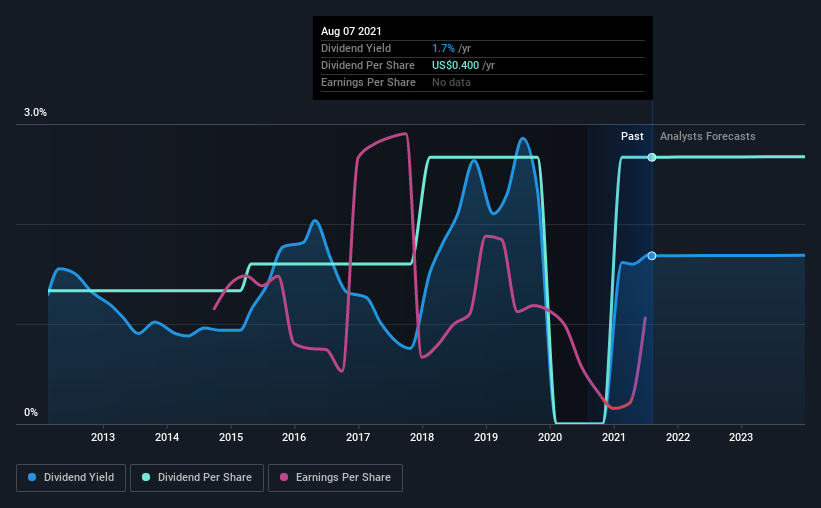Should You Buy Dana Incorporated (NYSE:DAN) For Its Upcoming Dividend?
Some investors rely on dividends for growing their wealth, and if you're one of those dividend sleuths, you might be intrigued to know that Dana Incorporated (NYSE:DAN) is about to go ex-dividend in just three days. The ex-dividend date is one business day before a company's record date, which is the date on which the company determines which shareholders are entitled to receive a dividend. The ex-dividend date is of consequence because whenever a stock is bought or sold, the trade takes at least two business day to settle. This means that investors who purchase Dana's shares on or after the 12th of August will not receive the dividend, which will be paid on the 3rd of September.
The company's next dividend payment will be US$0.10 per share, on the back of last year when the company paid a total of US$0.40 to shareholders. Based on the last year's worth of payments, Dana has a trailing yield of 1.7% on the current stock price of $23.78. If you buy this business for its dividend, you should have an idea of whether Dana's dividend is reliable and sustainable. As a result, readers should always check whether Dana has been able to grow its dividends, or if the dividend might be cut.
Check out our latest analysis for Dana
Dividends are typically paid from company earnings. If a company pays more in dividends than it earned in profit, then the dividend could be unsustainable. Dana paid out just 14% of its profit last year, which we think is conservatively low and leaves plenty of margin for unexpected circumstances. Yet cash flow is typically more important than profit for assessing dividend sustainability, so we should always check if the company generated enough cash to afford its dividend. What's good is that dividends were well covered by free cash flow, with the company paying out 11% of its cash flow last year.
It's encouraging to see that the dividend is covered by both profit and cash flow. This generally suggests the dividend is sustainable, as long as earnings don't drop precipitously.
Click here to see the company's payout ratio, plus analyst estimates of its future dividends.
Have Earnings And Dividends Been Growing?
Companies with consistently growing earnings per share generally make the best dividend stocks, as they usually find it easier to grow dividends per share. If business enters a downturn and the dividend is cut, the company could see its value fall precipitously. With that in mind, we're encouraged by the steady growth at Dana, with earnings per share up 8.2% on average over the last five years. Earnings per share have been growing at a decent rate, and the company is retaining more than three-quarters of its earnings in the business. If profits are reinvested effectively, this could be a bullish combination for future earnings and dividends.
Another key way to measure a company's dividend prospects is by measuring its historical rate of dividend growth. Since the start of our data, nine years ago, Dana has lifted its dividend by approximately 8.0% a year on average. We're glad to see dividends rising alongside earnings over a number of years, which may be a sign the company intends to share the growth with shareholders.
The Bottom Line
Has Dana got what it takes to maintain its dividend payments? Earnings per share growth has been growing somewhat, and Dana is paying out less than half its earnings and cash flow as dividends. This is interesting for a few reasons, as it suggests management may be reinvesting heavily in the business, but it also provides room to increase the dividend in time. It might be nice to see earnings growing faster, but Dana is being conservative with its dividend payouts and could still perform reasonably over the long run. Overall we think this is an attractive combination and worthy of further research.
On that note, you'll want to research what risks Dana is facing. To help with this, we've discovered 2 warning signs for Dana that you should be aware of before investing in their shares.
If you're in the market for dividend stocks, we recommend checking our list of top dividend stocks with a greater than 2% yield and an upcoming dividend.
This article by Simply Wall St is general in nature. It does not constitute a recommendation to buy or sell any stock, and does not take account of your objectives, or your financial situation. We aim to bring you long-term focused analysis driven by fundamental data. Note that our analysis may not factor in the latest price-sensitive company announcements or qualitative material. Simply Wall St has no position in any stocks mentioned.
Have feedback on this article? Concerned about the content? Get in touch with us directly. Alternatively, email editorial-team (at) simplywallst.com.

